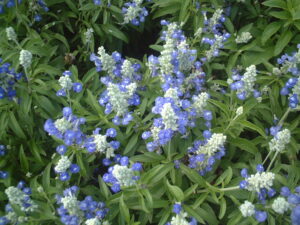( Salvia Farinacea ‘ Strata ‘ )
Perennial Salvia Strata Origins:
Salvia Farinacea is native to Mexico and some of the southern United States including Texas and New Mexico.
Most often planted as an annual in cooler regions of the USA, here in North Florida / Jacksonville / St.Augustine area it makes a wonderfully reliable semi evergreen to herbaceous perennial planting.( may be winter
dormant depending on planting location)
Salvia Strata is a selection of Salvia Farinacea grown for its abundant bicolored flowering display and extremely compact growth habit.
This compact low maintenance plant is perfect for Florida’s hot summers and keeps on blooming when other flowering plants have begun to decline. Simply pinch back spent flowers during the heat of the summer and watch it bloom all over again in a matter of weeks!
Salvia Strata Preferred Exposure:
– Salvia Farinacea Strata will need a full sun or partial sun exposures in the North Florida | Jacksonville | St. Augustine area gardens landscape.
– To bloom its best afternoon sun is preferable to morning sun when planting in a partial sun partial shade site.
Salvia Strata Foliage:
– Light gray- green delicate elongated foliage, semi evergreen to herbaceous
depending on the winter season, leaves often go dormant for the winter season.
– Don’t toss the roots to these plants as they are likely to regrow
quickly in the following spring season. I like to over plant mine with a cool season annual like pansy’s or snapdragons that will bloom all winter and be done by the time the foliage re-emerges late the following spring.
Salvia Strata Soil Preference / Salt tolerance:
-Salvia Strata is not particular about the components of the soil it is planted in providing they are planted in a well draining location.
– Unknown Salt tolerance. Have it at the beach? Let us know how it did!
Salvia Strata Bicolor Size Variance:
– Salvia Strata is a very compact selection of Salvia Farinacea most often found growing at just 12-14 inches high and 6 – 8 inches wide. Ideal for lower growing and front of the border plantings or even mixed flowering containers.
Salvia Strata Growth Habit:
– Semi evergreen to herbaceous perennial plant forms an attractive upright mound of foliage, taller than it is wide, particularly attractive when planted in masses.
Salvia Strata Growth Rate:
– Fast growing Salvia Strata can be expected to reach its full height within a month of being planted in the Florida | Jacksonville | St. Augustine area landscape.
Salvia Strata Bloom:
– Beautiful bright blue and white flower stalks rise above the foliage in summer and fall.
– Salvia Strata blossoms make excellent cut flowers, and removing spent blossoms promotes more blossoms so cut to your hearts content!
– Remove spent blooms and cut foliage back after flowering begins to decline and the plant will regrow and rebloom within weeks!
Salvia Strata Water Requirements:
– Although moderately drought tolerant. plants perform best when supplemental irrigation is supplied.
– Regular water is necessary to get the plant rooted and growing on its own after being planted in the ground from a nursery container.
Butterfly or Bird Attracting:
– S & J Nursery’s Salvia Strata will attract butterflies and hummingbirds to
your North Florida gardens landscape.
Best Uses For Salvia Strata in the North Florida | Jacksonville | St. Augustine
area garden:
– Easy maintenance blooming plant for perennial beds and flower borders.
– Great selection for a mixed container planting.
– Plant in masses for a blooms display that cant be missed!
– Salvia Strata makes a great companion plant for other perennials in the garden and adds a strong vertical element when in bloom.
– Use as a cut flower!
– Deer resistant flowering selection!
Care of Salvia Strata in the North Florida | Jacksonville | St. Augustine area
landscape:
– Water every day during the establishment period after planting in the garden from a nursery container, once plants have established themselves into the landscape, you can begin to taper watering back to just a semi weekly application if local rainfall levels are low.
– Leave foliage and roots in place for next years growth.
– Trim back both foliage and blooms when flowering begins to decline in late summer for faster fall blooms. Fertilize when trimming and the plant will be back again and blooming even if pruned off at ground level within weeks!!! ( I snap my stems down to ground level and just let the whole thing regrow to keep them nice and tidy, but you could if you weren’t quite as lazy as I am trim back just a few inches and fertilize)
– Fertilize each spring, and again when trimming in late summer with a handful of garden compost or a mixture of Milorganite and a slow release poly coated plant food such as Osmocote or Stay Green general purpose plant food.


